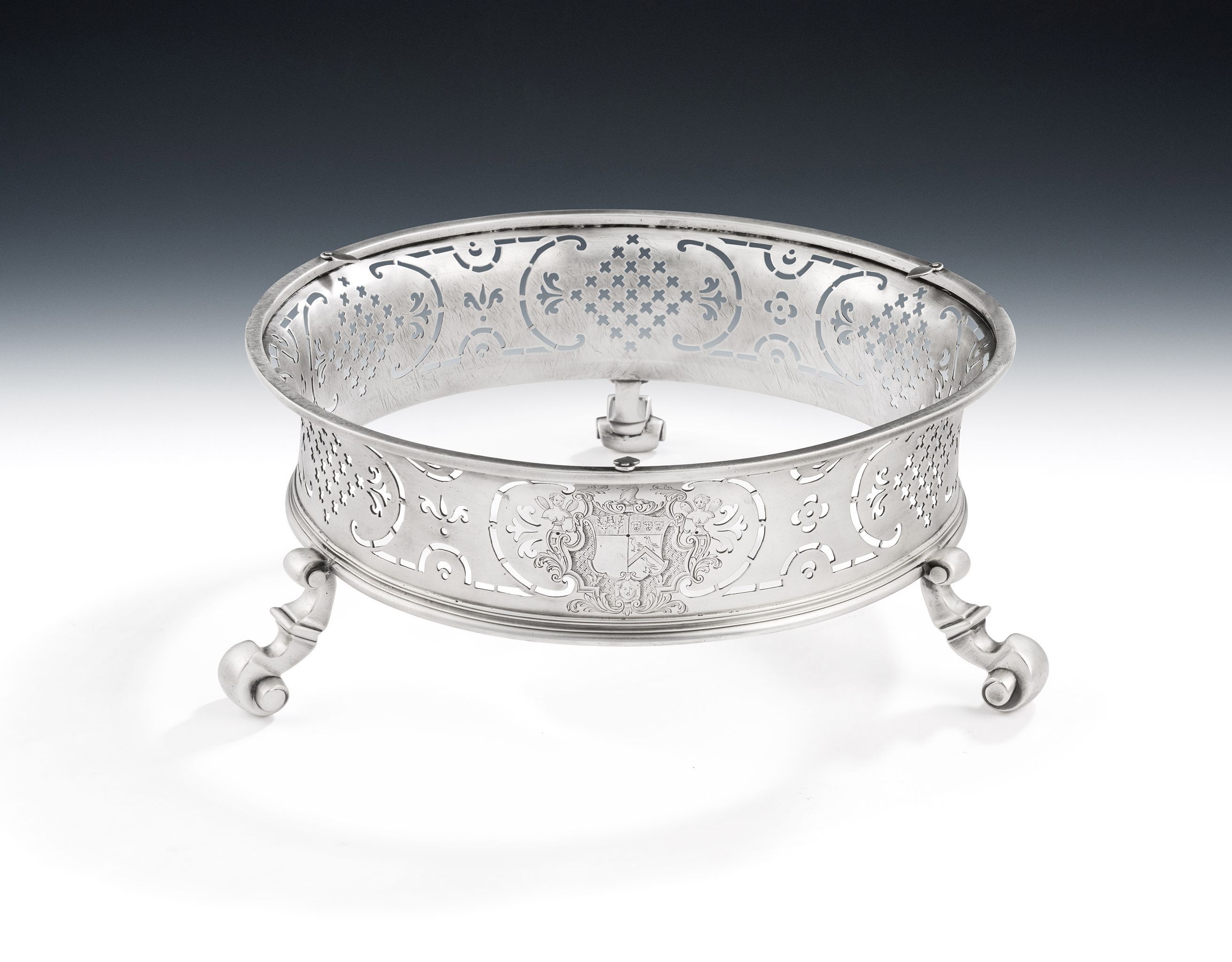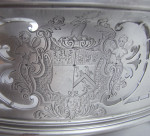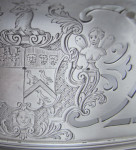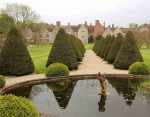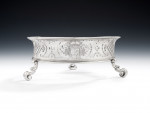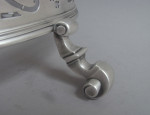The Littlecote House Dish Ring. An important George II Dish Ring made in London in 1738 by William Lukin.
The Littlecote House Dish Ring. An important George II Dish Ring made in London in 1738 by William Lukin.
375463
This exceptionally rare item is modelled in a large circular form which is raised on three cast double scroll legs applied to a stepped and reeded wire. The sides rise to an everted rim which are pierced with lozenge shaped panels and crosses, flanked by scrolls of stylised foliate form within large "C" scrolls. Each panel is separated by similarly pierced quatrefoils with arches above and below. The front is engraved with one of the finest Armorials we have seen surrounded by a cartouche of foliate scroll work, flanked by very unusual female winged busts each side. The base displays a male mask, with trellis work designs around. The rim is fitted with three swivel flaps to hold the dish in place. The Dish Ring is in quite excellent condition.
Dish rings in English silver are considerably rarer than their Irish counterparts and appear generally about 40 years before those in Ireland. The ring is fully marked on the side in the piercing. The top of the date letter is present so that we can certainly conclude that it is 1738 and the bottom of the distinctive punch of William Luckin. An unmarked but more elaborate dish ring is in the Victoria and Albert Museum and is illustrated in: Michael Clayton, "The Collector's Dictionary of the Silver and Gold of Great Britain and North America, p.114, no. 243. This is dated to circa 1735. The size of the Lukin Dish Ring is impressive and would have supported a large pottery or porcelain bowl to protect the table from excessive heat.
Height: 4 inches, 10cm.
Diameter: 10.25 inches, 25.63 cm.
Weight: 26oz.
PROVENANCE
The Armorial is that of Popham for General Edward Popham who was born in 1712 He married Rebecca Huddon of Hungerford who was three years his senior and he became MP for Wiltshire between 1741 to 1747 and 1751 to 1761. He died in 1772. The Popham family lived at the fabulous Littlecote House in Wiltshire. They were very distinguished being descendants of Edward III. Also Sir John Popham 1731-1607 presided over the trials of the Earl of Essex, Sir Walter Raleigh and Guy Fawkes.
LITTLECOTE HOUSE.
Littlecote House is a large Elizabethan country house and estate in the civil parishes of Ramsbury and Chilton Foliat, in the English county of Wiltshire. The estate includes 34 hectares of historic parklands and gardens, including a walled garden dating from the 17th and 18th centuries. In its grounds is Littlecote Roman Villa. A Grade I listed building, Littlecote House is now a luxury hotel. The first Littlecote House was built during the 13th century and was the home of the Calstone family from around 1290. In 1415 Elizabeth de Calstone married William Darrell and the Darrell family inherited the estate. Elizabeth Darrell's half-niece, also named Elizabeth Darrell, was a maid of honour to Henry VIII's first Queen Catherine of Aragon and had a well-publicised affair with the poet, Sir Thomas Wyatt.
In the mid-1530s, King Henry VIII is said to have courted his third wife, Jane Seymour, at Littlecote, the reason seems to be that Jane's grandmother was Elizabeth Darrell. The last of the Darrell owners is connected with several scandals and the house's resident ghost story. William Darrell's father had left the house to his mistress Mary Danyell, but Darrell was able to recover it when he came of age in 1560. He spent lavishly, left his debts unpaid, and went to law with most of his neighbours, acquiring enemies in the process. Sir John Popham was his relative and lawyer. Sir John Popham bought the reversion of Littlecote, and succeeded to it on Darrell's death in 1589; he then built the present Elizabethan brick mansion, which was completed in 1592.
James I, Charles II and William of Orange stayed there, the latter on his march from Torbay to London in the so-called "Glorious Revolution" of 1688 in which he superseded the Catholic King James II. A unique room that can still be seen today is the so-called "Dutch Parlour". A plaque in the corridor outside states that this was decorated with paintings by Dutch seamen who were captured in about 1666 in a war between England and the Dutch; these paintings cover the walls and the ceiling.
RELATED ITEMS

